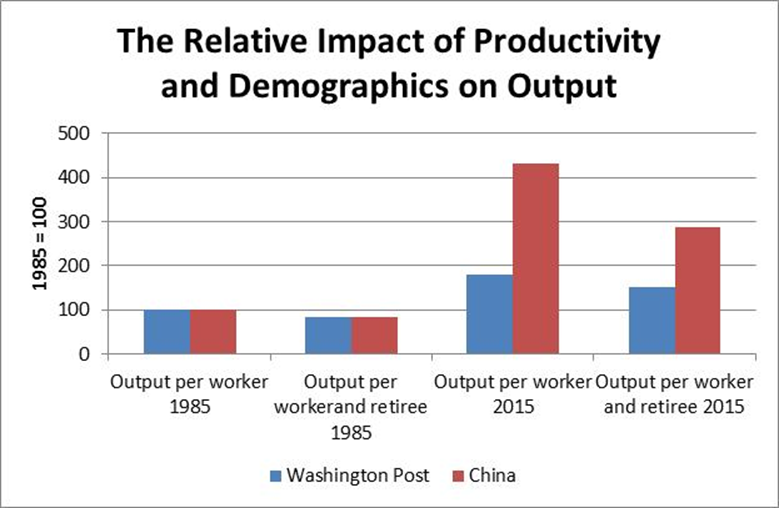November 01, 2015
The end of China’s one child policy is producing an outpouring of nonsense about demographics. Nowhere is the confusion greater than in the opinion pages of the Washington Post, which gets the gold medal for confusion on this issue. In honor of this occasion, BTP will explain the issue in a way that even a Washington Post editorial page editor could understand.
The key point here is that the ability to support a given population of retirees depends not only the ratio of workers to retirees, but also the productivity of the workers. The Post again told readers today that China faces a terrible demographic problem because of its one-child policy.
“Even with its recent rapid economic growth, China is growing old before growing truly wealthy; its shrinking labor force will be hard-pressed to support the millions of dependent elderly.”
To see why this is not true, we will take a very simple story where we contrast a country with moderate productivity growth and no demographic change with a country rapid productivity growth and a rapid aging of its population. The figure below shows the basic story.

Source: Author’s calculations.
We assume that in 1985 there are five workers to every retiree in both the Washington Post and China story. If we set output per worker in 1985 equal to 100, then the amount of output per worker and retiree in 1985 is 83.3 (five sixths of the output per worker). We then allow for different rates of productivity growth and population growth over the next three decades.
In the China scenario, we have 5.0 percent annual productivity growth. This is somewhat slower than the actual rate of growth of output per worker over the last three decades, but it is still sufficient to make the point. The calculation assumes the ratio of workers to retirees falls to just two to one, a sharper decline than has actually been the case.
In the Washington Post scenario, we assume a moderate 2.0 percent rate of productivity growth, roughly the average rate for the U.S. economy over the last three decades. To make the case extreme in the other direction, it is assumed there is no change in the ratio of workers to retirees so that in 2015 the ratio is still five to one.
As should be obvious, in the high productivity case output per worker is far higher in 2015 than in the Washington Post scenario. Output per worker reaches 432.2 in 2015 in the China scenario, compared to just 181.1 in the Washington Post scenario.
Because of the extraordinary differences in output per worker, China is still much better capable of supporting its retired population in 2015 than a country following the Washington Post scenario. Its output per person is equal to 288.1 in 2015. This means that both its workers and retirees can enjoy an income that is 188.1 percent higher in 2015 than it was in 1985. By contrast, in the Washington Post scenario output per person in 2015 is just 150.9 in 2015, meaning that its workers and retirees can only enjoy an income that is on average 50.9 percent higher than in 1985.
In this case, it should be evident that China will have a much easier time supporting its retirees than a country that had enjoyed just moderate productivity growth and no demographic change. It is also worth noting that some demographic change was inevitable. Regardless of what policies China had pursued it was going to see an aging of its population, which would have meant a decline in the ratio of workers to retirees.
These numbers also overstate the benefits of the Washington Post scenario for two other reasons. The numbers treat retirees as the only dependents. Of course there are also children. The ratio of children to workers would be far larger in the Washington Post scenario than in the China scenario. Incorporating children into the calculation would further increase the gap in the change in output per person between the two scenarios.
The other difference is that the Washington Post scenario of more rapid population growth would imply much greater strains on China’s natural resources. The country would require much more food and water and emit a much larger amount of greenhouse gases into the atmosphere. This would further reduce the standard of living in the Washington Post scenario relative to the China scenario shown here.
Anyhow, there are solid reasons to applaud the end of China’s one-child policy on human rights grounds. But the Washington Post’s economic indictment can’t stand up to simple arithmetic.







Comments